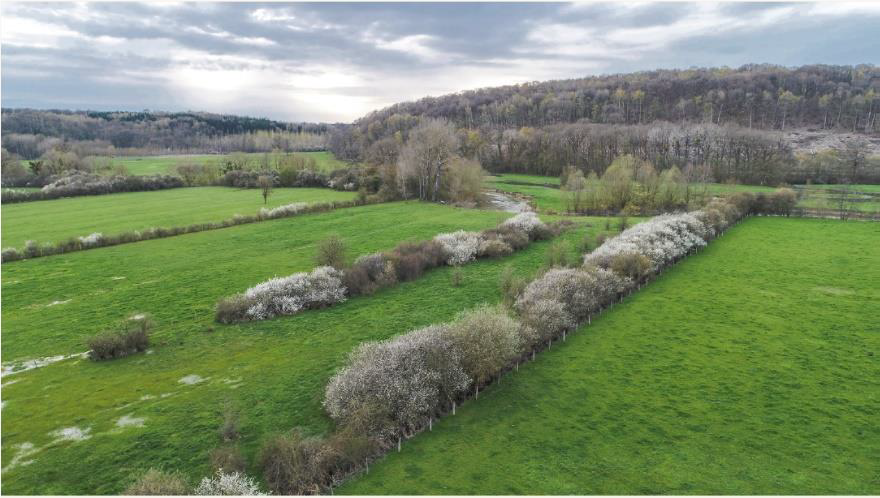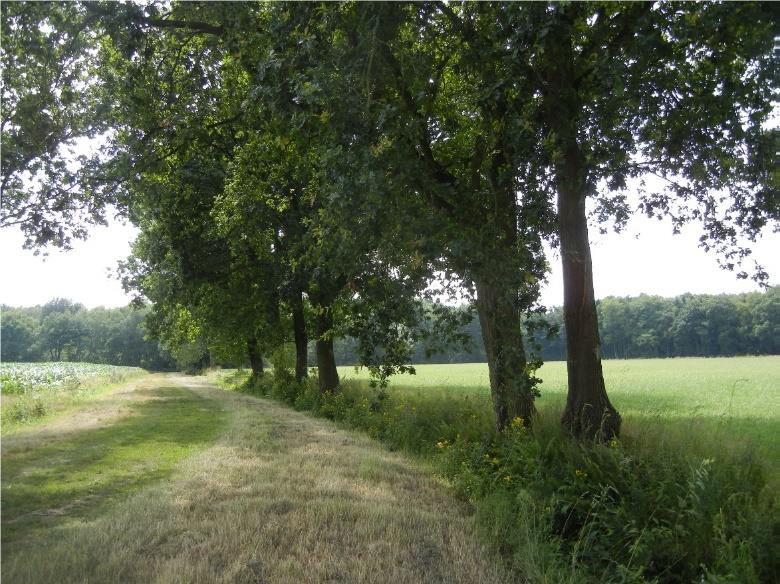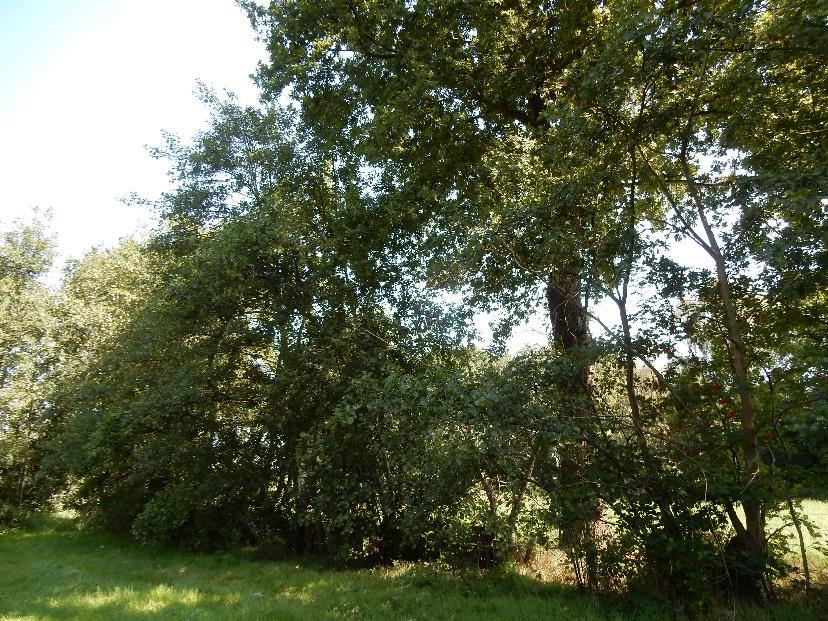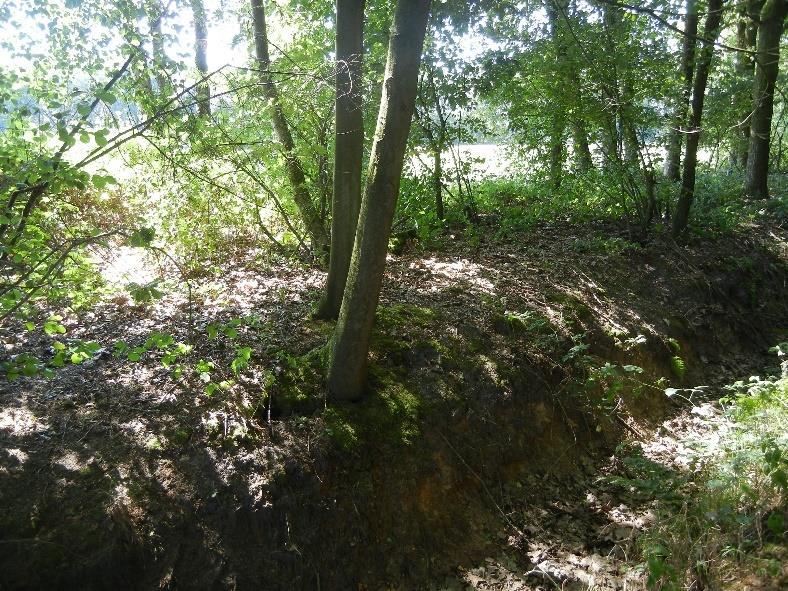
https://ec.europa.eu/eip/agriculture/en/find-connect/projects/bovine-beef-innovation-network-europe
INNOVATION EXPLAINED
A hedgerow system is a type of agroforestry system, where lines of trees and permanent vegetation are grown on/around agricultural fields. Different hedgerow systems exist. The box underneath explains the different types.
These systems have a great potential to mitigate climate change, as in both above- and below ground tree biomass and the soil, carbon (C) can be sequestered. In Flanders, hedgerow systems can be unmanaged (hedgerows and wooded banks), occasionally trimmed (hedges), end up in clear cut (tree rows) or are under rotational management (hedgerows and tree rows). When cuttings, deadwood or litter fall are left underneath the hedge, part of the C can go back into the cycle. The amount of C going back via this pathway into the cycle is not known. Research is being done by Teagasc to investigate this.
Compared to other agroforestry systems (eg. silvopastures), in hedgerows the amount of C directly underneath the hedge will be the highest. This because the hedge also counts as a windscreen. Litter fall stays underneath the hedge and helps in this higher C level.

Hedge
A hedge is a linear strip of woody vegetation surrounding agricultural land. No tall trees are included, so the hedge is not exceeding 15m. A hedge can consist of one species or be multispecies. A hedge translates to ‘haag’ in Dutch
|
 Tree row Tree rowIn a tree row, on particular tree species is planted without shrub layer. It translates to ‘bomenrij’ in Dutch
|

Hedgerow
Linear strip of woody vegetation in open landscape. It consist of shrubs (<15m) an trees (>15m). It is heterogenous (different species) and an uneven-aged ecosystem. This translates to ‘houtkant’ in Dutch.
|
 Wooded bank Wooded bankA woodbank is a hedgerow on elevated ground. These have typically ditches at both sides. This translates to ‘houtwal’ in dutch
|
Source images: Van Den Berge, S. (2021)
The impact on C sequestration of hedgerows is influenced by several factors, including climatic conditions, livestock-grazing intensity and soil type.
Climatic conditions
A factor to look at related to C-sequestration is CO2 efflux. In a normal situation, C is exchanged between the different pools (soil, atmosphere and oceans) by processes like photosynthesis, respiration and decomposition. It is expected that as global temperatures increase, microbial activity will also increase, resulting in a faster decomposition and an increase in soil C efflux Measuring this exchange/efflux can help to understand and predict effects of global warming.
The study of Ford et al. (2021) showed an increased CO2 efflux with an increase in soil temperature, but this efflux was negatively associated with soil moisture content. This means that higher temperatures will increase the release of C to the atmosphere. Also well-drained soils (lower moisture level) will lead to a greater C efflux. In contrast, in more wet areas, C storage is enhanced.
Livestock grazing
Livestock grazing is often associated with enhanced biomass beneath the soil and root turnover. Together with hotspots of CO2 emissions from livestock dung, a higher CO2 efflux is seen in intensively grazed grasslands.
Soil type
Clay soils have a higher carbon holding capacity, when compared to sandy soils.
Drexler et al. (2021) performed a meta-analysis and found that hedgerows on cropland increased SOC (soil organic C) stocks with 32%, compared to no hedgerows. No significant differences in SOC were found between hedgerows and grasslands. Hedgerows were estimated to store 104 Mg ha-1 more than croplands, with 84% in the biomass and 16% in the soil. They concluded that hedgerows have a similar potential of C sequestration compared to forests.
Benefits for agriculture
Carbon in the soil will increase soil fertility and nutrient cycling, slow down pesticide movement, and enhance water quality. As the soil health improves, less fertilizer is needed to obtain a similar crop production. Farms become also more resilient against both drought and heavy rainfall. In addition, a hedge around a field may provide shelter from sun and wind for the animals grazing, and can as well act as food source (nuts, berries, leaves, etc.).
Other benefits
Hedges will have a more extended root system belowground, compared to grass, which will hold more water and can counteract erosion.
Directly underneath the hedge, more shadow is present, as well as higher soil moisture content, which induces a microclimate.
Hedges will attract insects, birds and other wildlife, which increases biodiversity in the area.
Types of vegetation
In Flanders, bordering agricultural land, you will often find species containing thorns. Most popular is hawthorn and sometimes blackthorn. Species with thorns are perfect as a cattle fence, as you do not need another fence anymore, and the cattle keep it nice and short on the inside. Especially hawthorn is a valuable forage species. However, these thorns are also a disadvantage, as maintenance can be more difficult. When maintaining the hedge yourself (for possible further use as brown power for compost, directly as woodchips in the field or as litter material), it can be interesting to choose species with no thorns. Common species in Flanders are dogwood, field maple, spruce, hornbeam, elm, spindle and hazel.
FURTHER INFORMATION
As hedgerows can provide more than C-sequestration, it is interesting to adopt the type of plant to your farm and your expectations of a hedge. A hedge can also provide extra food for the animals, some have more extended root systems for erosion, etc.
In Flanders there is a project ongoing ‘Weidescherm’ where they will determine adequate planting to provide shelter for animals kept outdoors. This project is not taken C-sequestration into account, however in one of the work packages they will develop practical information sheets on the construction and management of different types of natural shelter (wood banks, hedges, hedgerows, tree rows, etc.). In addition, they will also formulate an ‘Agroforestry Planner’, specifically aimed at supporting farmers in making a suitable choice of three species based on parcel and farm type. For more information, click here (Dutch).
IMPACT ON FARM PERFORMANCE
Socio-economic resilience
- Putting hedges on your field is an investment. On the other hand, it can provide an income (via selling the clippings), makes a pasture more attractive for consumer, lower the fertilizer need and premiums might be available in your region
Animal health and welfare
- A hedge can provide extra shelter for the animals on field
- Feeding trees: extra minerals and trace-elements
Production efficiency and meat quality
Environmental sustainability
- C-sequestration
- Additional positive effects on enteric fermentation with some species (e.g. hazel)
INTERESTING LINKS
EIP-Agri focus group Agroforestry: Click here
EIP-Agri focus group Agroforestry: introducing woody vegetation into specialized crop and livestock systems: Click here